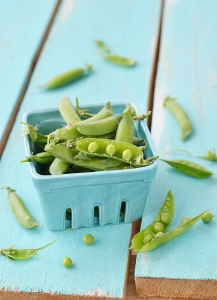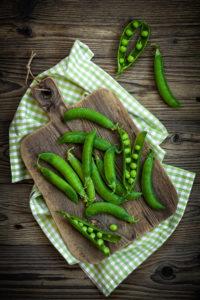 Did you know? Thick London fogs of the 19th and 20th centuries were dubbed ‘pea-soupers’ because of their density and green tinge. There are 35,000 hectares of peas grown in the UK each year, equivalent to about 70,000 football pitches. This produces about 160,000 tonnes of frozen peas – that’s 2 billion 80 gram portions. In 1969 the Birds Eye frozen pea commercial was the first TV ad to be broadcast in colour.
Did you know? Thick London fogs of the 19th and 20th centuries were dubbed ‘pea-soupers’ because of their density and green tinge. There are 35,000 hectares of peas grown in the UK each year, equivalent to about 70,000 football pitches. This produces about 160,000 tonnes of frozen peas – that’s 2 billion 80 gram portions. In 1969 the Birds Eye frozen pea commercial was the first TV ad to be broadcast in colour.
Most of us have been familiar with peas since childhood, and have finally found the skills to scoop them up without them rolling off our cutlery and bouncing all over the floor. It’s just as well, as they’re a fab food and great for the diabetic diet.
Our fondness of peas may be DNA-deep, as the oldest pea ever found was nearly 3,000 years old and discovered on the border of Burma and Thailand. While that pea was inedible, green peas are one of the most nutritious leguminous vegetables.
Green peas are winter crops. Fresh peas are readily sold from December until April in the markets. Green-peas are at their best soon after their harvest since much of sugar content in the seeds rapidly converted into starch. If you have to store at all, place them in the vegetable compartment inside the home refrigerator, set at high relative humidity where they keep fresh for 2-3 days. Frozen peas can be stored for several months.
Super greens
Peas contain no fat, no cholesterol and almost no sodium (see full list of nutritional values at the end of this article). Peas flaunt twice the protein of most vegetables, so they’re the ideal substitute for fattier protein sources, therefore helping control your fat intake. Their iron content is particularly important since it’s hard to find non-animal foods. Vitamin K has an established role in Alzheimer’s disease patients, limiting neuronal damage in the brain. Vitamin A is an essential nutrient required for maintaining healthy membranes, skin and eye-sight. peas are also good in many other essential B-complex vitamins such as pantothenic acid, niacin, thiamin, and pyridoxine. Furthermore, they are rich source of many minerals such as calcium, iron, copper, zinc, and manganese.
Despite being very low in fat, the fat peas do contain is the best. Recent research has shown that green peas are a reliable source of omega-3 fats in the form of alpha-linolenic acid (ALA). In one cup of green peas, you can expect to find about 30 milligrams of ALA. About 130 milligrams of the essential omega-6 fatty acid, linoleic acid, can also be found in a cup of green peas. This very small but high-quality fat content of green peas helps provide important fat-soluble nutrients to the diet, including sizable amounts of beta-carotene and small but valuable amounts of vitamin E.
 Other peas
Other peas
Snow peas and other edible-podded peas don’t contain the same amount of protein or nutrients green peas do. But they are rich in iron and vitamin C, which help maintain your immune system. Peas have lutein, the carotenoid with a proven record of helping to reduce the risk of age-related macular degeneration and cataracts. Fresh snow peas, also known as Chinese pea pods, are increasingly available year-round. Look for small, shiny, flat pods; they’re the sweetest and most tender. Avoid cracked, overly large, or limp pods. Sugar snap peas are edible pods like snow peas, but sweet like green peas. Select plump, bright-green pods. Fresh peas don’t keep long. Because their sugar quickly turns to starch, the sooner you eat them the more full of flavour they’ll be. When you can’t get fresh peas, use frozen.
How to prep a pea
Wash peas just before shelling and cooking. To shell, pinch off the ends, pull down the string on the inside, and pop out the peas. Steam for a very short time: six to eight minutes. They’ll retain their flavour and more vitamin C if they keep their bright green colour, and the less water you use when cooking them, the less Vit C is lost. When boiling frozen peas, add enough water to cover, bring to the boil, then cover and simmer for 3 mins. In a microwave, for 8oz of frozen peas add 1 tablespoon of water, cover and cook on full power for 4mins (750W). Snow peas just need washing and trimming before cooking or eating raw. Sugar snap peas need the string removed from both sides. Snow peas are perfect in stir-fries cook briefly for just a minute or two.
Fully loaded
There seems to be an association between green pea and legume intake and lowered risk of type 2 diabetes. Some research has speculated that may be connected not only with the relatively low glycemic index of green peas (about 45-50) and their strong fibre and protein content, but also with this unusual combination of antioxidant and anti-inflammatory phytonutrients.
Green peas are loaded with antioxidants and anti-inflammatory nutrients. We also know that intake of green peas is associated with lowered risk of Type 2 diabetes, even though this association has traditionally been understood to involve the strong fiber and protein content of green peas. Researchers now believe that the antioxidant and anti-inflammatory nutrients in greens peas play an equally important role in lowering our risk of this chronic health problem.
Few foods provide us with such substantial amounts of protein or fibre (about 8-10 grams per cup for each of these macronutrients) as green peas. These outstanding fibre and protein amounts directly regulate the pace at which we digest our food. By helping to regulate the pace of digestion, protein and fiber also help regulate the break-down of starches into sugars and the general passage of carbs throughout digestive tract. With better regulation of carbs, our blood sugar levels can stay steadier.
(with thanks to whfoods.org)
The Nutritional value of fresh peas, cooked per 100g
81 cals
6% potassium
14g carbs (6g sugar)
20% dietary fibre
5g protein.
Iron, 1mg
15% Vitamin A
66% Vitamin C
10% Vitamin B-6
8% Magnesium
21% Vitamin K
From Peas.org
- Freshly frozen garden peas and petits pois are frozen within just two and a half-hours of being picked. This locks in all the nutrients, which can be lost at room temperature.
- Freshly frozen garden peas and petits pois conveniently take three minutes to cook.
- One serving of freshly frozen garden peas and petits pois contains as much vitamin C as two large apples, more fibre than a slice of wholemeal bread and more thiamine than a pint of whole milk.
- Peas are a versatile vegetable, tasting great in risotto, kedgeree, omelettes, pizzas, pastas, soups, salads, casseroles and curries.
- The speedy freezing process preserves the sweet and succulent taste that can otherwise be rapidly lost.
- No matter the season, freshly frozen garden peas are available throughout the year.
- The freezing process preserves the lustrous pea green colour that adds vibrancy to so many dishes.
- Being freshly frozen, there’s absolutely no preparation needed. Just add to your recipe or pop them straightinto soups, casseroles or curries.
- There’s no wastage. Garden peas or petits pois chosen for freezing are the pick of the bunch. There are no duds.
- There’s nothing added to freshly frozen garden peas: no salt, sugar or water and certainly no other preservatives or additives. Just Mother Nature’s own way of preservation: freezing.
This news item first appeared in our free-to-receive online magazine. We cover diabetes news, diabetes management equipment (diabetes kit) and food news for the diabetic diet. Go to the top of this page to sign up – we just need your email address.



